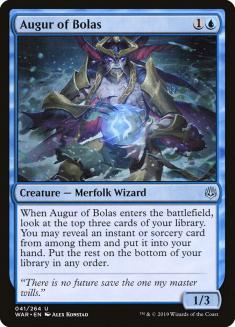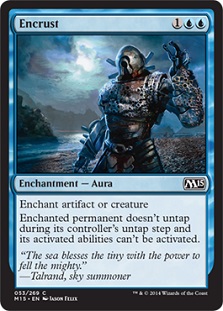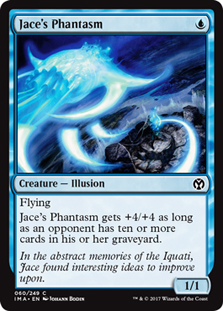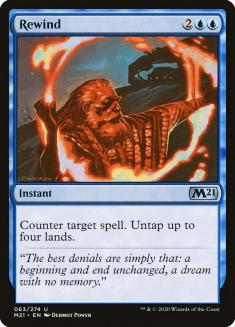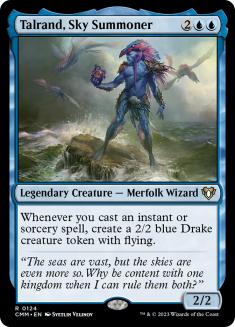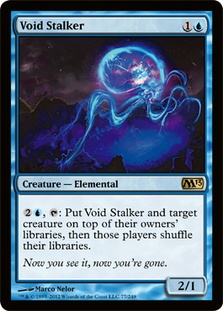We’re at a moment in Standard that is one of two moments that are among the most interesting in the life cycle of the format. If you want to think of it in metaphors, you can think of it like some very strange version of the moon cycle. It would go something like this, if we were just talking Magic.

In Magic, right now, we’re basically at the Full Moon stage; all of two full block sets are here and we also have M12 and M13 about to be legal. With this many cards at our fingertips, some of the more interesting things that are possible in Standard can come about. Of course, with this much power, we also have the simple ecological effect of dominance: it is hard to be a rodent in Australia and compete with the European Rabbit. Asian Tiger Shrimp are slowly taking over in the Louisiana and Carolinas’ coasts. The simple fact of the matter is that in Magic, like in nature, once something gets into the environment, it can just push a lot of other decks out of contention. During the Full Moon stage, it may be the greatest opportunity for a deck to have the power to compete with other decks, but it is also a great opportunity for decks to have so many weapons at their disposal that they push everything else out, at least for the most part.
Unlike the lunar cycle, after the Full Moon Standard Magic doesn’t go into a Waning Gibbous Moon. Instead, with the coming of Return to Ravnica, we will lose an entire block. In a sense, we go right back to the Waxing Gibbous Moon.

This time is interesting because it is the time of greatest upheaval. Huge portions of decks can disappear, and in the gaps of the old order, new decks, which may not have been powerful enough before that moment, can emerge.
This is a part of the reason that I continue to develop decks that have “failed,” if only briefly. Their time can emerge, whether it is because of the removal of cards and decks from an environment or because of the introduction of them. Either way, decks that were, before this moment, not good or worthwhile can become worthy of consideration. It’s also a reason that I try to work on Block Constructed formats regardless of whether there is anything “current” going on in them; the lessons from that can become very relevant when we enter a Gibbous Moon in Magic or when simply a new card emerges that makes it so.
This is also a reason that deck’s from Magic’s history matter: new formats may emerge that are remarkably similar to old ones or decks can be possible that share a lot in common with ones from the past.
For this, take the case of Curious George.
The Case of Curious George
“George” was a deck designed by one of the best deck designers of all time, Mike Donais. Mike used to be found in the halls of Wizards of the Coast, but these days is a game designer for another company. Before all of that, though, he was a pro player of some small repute and a deck designer whose shadow loomed long.
For the first Grand Prix Austin, he built this amazing deck which utterly changed the landscape of that Block Constructed format. It won in the capable hands of Gary Krakower, a two-time Canadian National Champion. Here is “George,” the GP Austin 1998 winner:
3 Capsize
4 Counterspell
4 Curiosity
3 Dominating Licid
4 Forbid
4 Hammerhead Sharks
4 Legacy’s Allure
4 Manta Riders
3 Thalakos Drifters
2 Thalakos Seer
3 Tradewind Rider
19 Island
3 Maze of Shadows
Sideboard:
3 Bottle Gnomes
1 Helm of Possession
3 Portcullis
3 Mana Leak
2 Steal Enchantment
1 Thalakos Drifters
2 Stalking Stones
What made this deck so good was that it was an early mixed-strategy deck; not exactly an aggro-control deck like Merfolk but something closer to what we’ve seen in a more modern context, taking things slower and going for what I’ve been calling a hybrid control, a la Faeries. But, terminology aside, this was a deck that wasn’t exactly a beatdown deck, but at a certain point in the midgame it would just inexorably take over, attacking with some tiny creatures and negating whatever useful play the opponent might have.
The centerpiece of the deck was certainly Curiosity. One of the most insanely potent openings that you could manage with the deck was dropping a first turn Manta Riders and then follow up with a second turn Curiosity. From there, it was pretty likely that you could just shut down anything useful that the other person might be able to do. When it came to power within a format, George was a total house. Being Forbid-locked by someone was a painful experience, but unlike the Shard Phoenix–Forbid lock that Counter-Phoenix could manage, George’s Curiosity-based Forbid lock was even more inescapable.
In prepping for Worlds with Team Mythic (the precursor to Team SCG Black), I had a deck that was showing promise that was based on what George was doing. Jon Finkel said, to my amusement and pleasure, something like, “I hope this deck is good! I’d love to play something like it!”
It wasn’t quite good enough.
It wasn’t that it wasn’t good. It just wasn’t good enough. Other Delver decks were simply a better choice.
Here is the deck that I had built by that time:
Spells (29)
- 4 Mana Leak
- 4 Curiosity
- 4 Ponder
- 2 Negate
- 2 Sword of War and Peace
- 4 Gitaxian Probe
- 3 Psychic Barrier
- 4 Vapor Snag
- 2 Runechanter's Pike
Sideboard

This particular version of the list is the one that I made after Dungeon Geists was printed. It was a really solid decklist, but not overwhelmingly good. Just, basically, solid.
Boys and girls, solid is not enough.
A friend of mine in Madison, Nico Dragomanovits, played it at an SCG Open Series and didn’t do all that great with it, but he enjoyed himself. Nico had the pleasure of being chosen as a round 1 feature match, unbeknownst to me in the booth, simply because Glenn Jones loved the look of the list.
During the match, Eric Froehlich asked, “Why would you ever play a deck like that? It’s like Delver but with a bunch of bad cards.”
I will acknowledge that the list wasn’t as good as Delver. But I do think that at this point, all of the newer cards that hadn’t yet seen play, Runechanter’s Pike and Invisible Stalker, have both been vindicated. Further, Curiosity, as anyone who has played against it knows, is a tough damn card to beat!
It felt pretty good at the SCG Invitational this year to see Adam Boyd Mono-Blue Delver make it into the Top 8.
Spells (28)
- 4 Mana Leak
- 4 Ponder
- 2 Mutagenic Growth
- 4 Gitaxian Probe
- 4 Vapor Snag
- 2 Gut Shot
- 4 Runechanter's Pike
- 4 Thought Scour
Sideboard

With this deck in my mind and then after seeing Yuuya Watanabe’s nineteen-land Delver deck, I had some food for thought about where to go with George. Here is Yuuya’s list:
Creatures (15)
Lands (19)
Spells (26)

Curious About M13
So what are the incentives to stay in pure mono-blue? The big one is slightly more stable mana base that lets you run a few more specialty lands. A part of it, though, is that you actually also manage to have a few less draws that have the kind of stumbling that happens when you are balancing Glacial Fortress, Seachrome Coast, and non-basic lands of other types.
Slightly less big is the ability to cast several blue-dependent cards in the same turn. For example, a card like Psychic Barrier can be cast on top of other cards requiring blue without much strain.
Of course, you are giving up Restoration Angel and Moorland Haunt. That’s a huge deal.
Turning to M13, are there cards that you can add to the deck which, in addition to Phyrexian mana-based cards, you can use to give mono-blue some more power?
I think so. (Spoilers below!)
On a first pass, here are the cards that strike me as worthy of consideration for an updated George-style deck.
These six cards aren’t much, but they do represent a possibility for a lot of action that the deck previously didn’t have. One of the first things that I find exciting, though, is a card I haven’t heard all that much talk about: Void Stalker.
This might seem fairly innocuous, but I love what it does akin to what the original George did way back in the day: put something onto the table that could attack but then use it to take care of another creature from the opponent.
Especially in this time of Cavern of Souls, this seems important.
Here is another take of where I’d go with it:
Spells (27)
- 4 Mana Leak
- 4 Curiosity
- 4 Ponder
- 1 Disperse
- 1 Negate
- 4 Gitaxian Probe
- 3 Vapor Snag
- 2 Runechanter's Pike
- 4 Thought Scour
Sideboard

One of the things that became utterly clear when I was doing some initial playtesting is that Elesh Norn is a real, real problem. Holy crap is Elesh Norn a problem. It would be such a huge deal if it wasn’t for Cavern of Souls, but the two of them together is a huge problem. As a result, Phyrexian Metamorph has become even more important than it was before.
Metamorph helps out with the Elesh Norn problem a lot, and it also does a number of other things that are useful. Getting rid of a Thrun or a Geist of Saint Traft is a big deal, but besides that, it is a good thing to be able to add another Snapcaster to the mix or a huge monster from the opponent’s side.
I’m still not 100% on board with the Void Stalkers. A part of the reason that I’m only running three is that they keep going back into the deck. They seemed valuable for stealing some board presence back against decks that would otherwise be able to keep dropping problem after problem. It might not be exactly the right card, though, as five mana is a large investment to deal with something. At the same time, countering creatures actually feels pretty haphazard right now, so a Void Stalker, in some ways, is a super-nice Seal of Ether Well (kinda sorta).
Still, it was cumbersome.
The huge card to get back, though, was Sleep.
Hot damn, this card is a monster.
When you’re drawing extra cards and dropping things on to the table versus another aggressive deck, Sleep is insane. You can cast Sleep, swing in, draw cards, they can’t retaliate, and then you can Snapcaster your Sleep. Yikes!
Obviously, this deck is still in the early stages. I’d call this at the Beta stage. But I’m excited about the possibilities for the deck.
Jace’s Phantasm may be a card that should simply straight up be in the deck both as a potential beast against Delver decks that have gotten to a midgame or as a sideboard card for the same purpose. Talrand also may absolutely belong in the deck, at least in some numbers.
The thing about beginnings is that it takes time to make the edge of the blade sharp. And sometimes it is never good enough. But, someday it may be. One of the things I view as a key to success is being able to look at the times when things have been successful in the past, apply those lessons, and go from there.
Until next week,
Special Bonus Section
This is a second draft of a Goblins deck based on some ideas I’ve been working on for a while.
Creatures (24)
- 4 Mogg Flunkies
- 4 Goblin Chieftain
- 4 Goblin Arsonist
- 4 Spikeshot Elder
- 4 Goblin Wardriver
- 2 Krenko, Mob Boss
- 2 Thundermaw Hellkite
Lands (21)
Spells (15)

Enjoy! I’ll probably be working on it for the next many months. If you go to SCG Open Series, you can find me on my break from coverage seeking out as much Magic as I can, playing pickup games of Standard and Legacy probably with this and other decks! See you in St. Louis and Buffalo over the next month!

